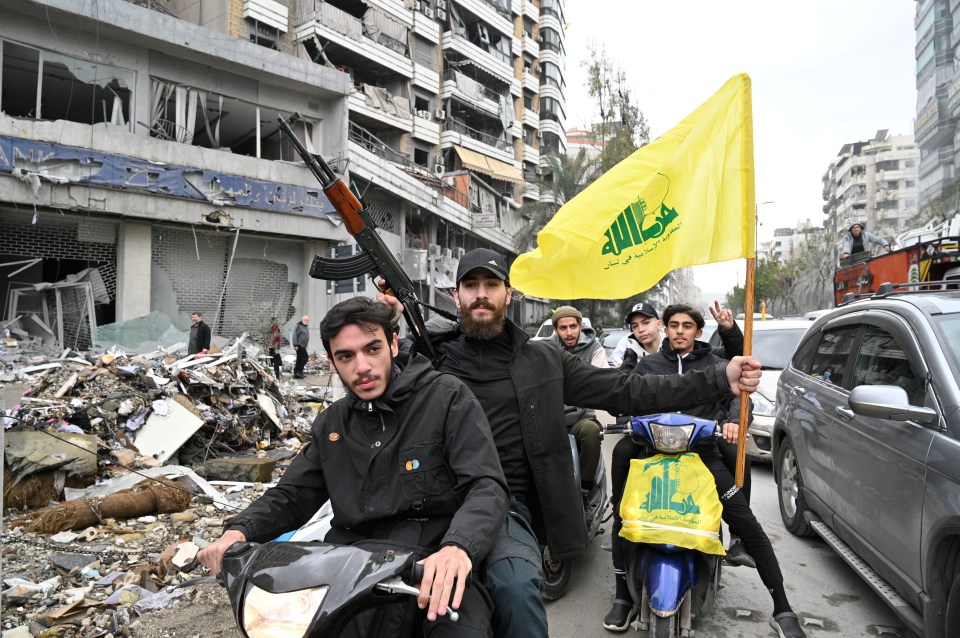ISRAEL’s fragile ceasefire with Hezbollah was under strain today as thousands flooded back towards Lebanon’s southern border cheering the terror group’s “victory.”
Queues of traffic built up along highways leading to the 20-mile buffer zone where Hezbollah forces and weapons are banned by the terms of the shaky truce.
EPALebanese people wave Hezbollah flags in the Dahieh district in southern Beirut[/caption]
EPACivilians celebrate on a street after the ceasefire with Israel came into effect[/caption]
Lebanese civilians flew yellow Hezbollah flags from cars and others approached Israeli tanks attempting to conduct a measured withdrawal from Lebanese territory.
Lebanese locals appeared to be ignoring Israel Defence Forces warnings not to return to southern villages which harboured terrorists so early in the ceasefire.
TV footage showed people walking around the town of Khiam close to an IDF tank in breach of the guidance.
Another clip posted on social media showed Lebanese returnees had even reached the border wall between the Lebanese village of Kafr Kila and the Israeli village of Metula.
The ceasefire – announced by Joe Biden after approval by Israeli PM Benjamin Netanyahu’s cabinet – came into force at 4am local time (2am in the UK).
But hopes of increased security began evaporating within hours as flag-waving Hezbollah supporters joined the returning throng.
Israel’s defence Minister Israel Katz said he was ordering the military to take “forceful” action to block what he says are Hezbollah members entering border villages.
Israeli troops are still operating in some of the communities after moving in to smash terror tunnels and weapons stores threatening Israel’s north.
Kat said that “due to the entry of Hezbollah members into Kfar Kila” he had ordered the military “to act forcefully and without compromises against developments of this kind.”
“If they endanger the IDF troops, they must be hit.”
The end to fighting officially kicked in at 2am this morning – with civilians flooding south to return to their homes.
Israel urged people not the return yet to areas in southern Lebanon – where much of the fighting has been concentrated.
The deal – which did not include Hamas – involves some 5,000 members of the Lebanese army being deployed to the south.
Hezbollah agreed to remove its presence anywhere below the Litani River just 20 miles from Israel.
Netanyahu pushed through the deal after nearly two months of conflict in Lebanon in which Israeli forces wiped out Hezbollah’s leaders and killed 3,000 troops.
Israel’s war with Hezbollah: a timeline
October 8, 2023: Hezbollah began firing rockets, missiles and drones into Israel the day after Hamas’ October 7 massacre ignited the war in Gaza.
September 18, 2024: Israel’s spy agency Mossad carried out mass sabotage against Hezbollah when it blew up hundreds of pagers carried by the terror group.
September 26, 2024: Chief of Hezbollah’s aerial force, Muhammad Hossein Sarur, is killed in an Israeli airstrike blitz in Lebanon.
September 27, 2024: Hezbollah leader Hassan Nasrallah is killed in a massive missile blitz in Lebanon.
October 1, 2024: Israeli forces invade Lebanon after Israel launched retaliatory airstrikes in Lebanon and the conflict steadily escalated.
October 13, 2024: Four Israeli soldiers were killed and 60 wounded in a Hezbollah drone swarm attack on base – the deadliest since Israel’s Lebanon invasion.
October 19, 2024: A terror drone attack launched by Hezbollah directly hit Prime Minister Benjamin Netanyahu’s seaside residence inside Israel.
October 19, 2024: Hezbollah also fired a salvo of more than 100 rockets into Israel, killing at least one person and injuring others in the northern region of the country.
October 31, 2024: Hezbollah’s new terror chief threatened to kill Israeli PM Benjamin Netanyahu in his first national address as leader.
November 2, 2024: Israeli soldiers capture top Hezbollah terror commander Imad Amhaz and escape from Lebanon in speedboats.
November 15, 2024: An Israeli missile levels a terror stronghold apartment block in Beirut.
November 17, 2024: Israel’s military said mobile artillery batteries had crossed into Lebanon and began attacking Hezbollah targets, the first time artillery was launched within Lebanese territory.
November 17, 2024: Hezbollah’s chief spokesman Mohammed Afif al-Naboulsi is killed in an Israeli airstrike in central Beirut.
November 26, 2024: Israel launched fresh airstrikes in Beirut, just hours before news of the ceasefire broke.
November 26, 2024: Israel agreed to the terms for a ceasefire with Hezbollah.
But he faced opposition from hawks who want the Iran-backed group totally destroyed amid warnings that they will re-arm and attack again.
The Israeli PM vowed to strike Hezbollah again if it were to break the ceasefire.
He said: “If Hezbollah tries to attack us, if it arms itself and rebuilds infrastructure near the border, we will attack.
“For every violation, we will attack with might.”
He added that there were three reasons to pursue a ceasefire: to focus on Iran, replenish depleted arms supplies and give the army a rest, and finally to isolate Hamas.
Just hours before the ceasefire deal was signed off, Israel wiped out 20 Hezbollah terror targets
The Israeli Defence Forces (IDF) said they targeted seven buildings used by the Iran-backed terror group for managing their funds – including a quasi-bank.
They also hit a Hezbollah air force centre, an intelligence base, a weapons depot and other military-style infrastructure.
Tel Aviv had vowed to wipe out the group after 60,000 citizens were evacuated from northern Israel.
EPAThe people defied Israel’s instructions not to return to the southern villages[/caption]
ReutersSmoke rises after an Israeli strike in Hamra[/caption]
AFPCivilians posing on a burnt Hezbollah rocket launcher in the village of Kfar Tibnit[/caption]

